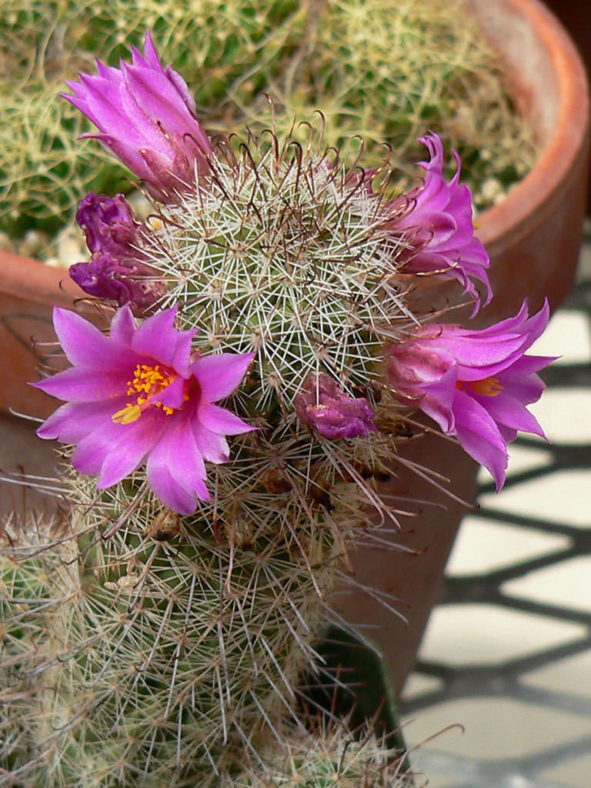Scientific Name
Cochemiea mazatlanensis (K.Schum. ex Gürke) D.Aquino & Dan.Sanchez
Synonym(s)
Chilita mazatlanensis, Ebnerella mazatlanensis, Escobariopsis mazatlanensis, Mammillaria mazatlanensis, Neomammillaria mazatlanensis
Scientific Classification
Family: Cactaceae
Subfamily: Cactoideae
Tribe: Cacteae
Genus: Cochemiea
Etymology
The specific epithet "mazatlanensis (maz-at-lan-EN-sis)" refers to the Mexican city of Mazatlán.
Origin
Cochemiea mazatlanensis is native to Mexico. It occurs along the Pacific coast, from southern Sonora, Sinaloa, Nayarit, Jalisco, and Colima to Michoacán.
Description
Cochemiea mazatlanensis, formerly known as Mammillaria mazatlanensis, is a small cactus that forms clumps of greyish-green, cylindrical stems with cone-shaped tubercles adorned with a cluster of white and reddish-brown spines at its tip. The stems can grow up to 6 inches (15 cm) tall and 2 inches (5 cm) in diameter. Each areole bears 1 to 6 central spines and 12 to 18 radial spines. The central spines are reddish-brown, usually straight, or sometimes one more or less hooked, measuring up to 0.6 inches (1.5 cm) long. The radial spines are white and needle-like, measuring up to 0.4 inches (1 cm) long.
The flowers are funnel-shaped and can reach up to 1.6 inches (4 cm) long and 1.2 inches (3 cm) in diameter. They range from pink and bright purple to carmine red and appear between the old tubercles at the upper part of the stems in summer. The club-shaped fruits are reddish-yellow or brown and contain tiny black seeds. They can grow up to 0.8 inches (2 cm) long.

How to Grow and Care for Cochemiea mazatlanensis
Light: For optimal growth of your Cochemiea mazatlanensis, ensure it is planted in an area that receives at least four hours of direct sunlight daily. If growing indoors, placing the cactus near a bright window is best to ensure it gets enough light. It is advisable to keep it on the balcony or in the garden from spring to fall for additional light.
Soil: To ensure good root aeration and drainage, use commercial cactus soil or create your own well-draining soil mix.
Temperature: Cochemiea mazatlanensis is heat tolerant but is not a cold-hardy plant. It grows best in USDA Plant Hardiness Zones 9b to 11b, with average minimum winter temperatures ranging from 25 to 50 °F (-3.9 to 10 °C).
Watering: Water deeply from spring to fall, and wait until the soil dries out before watering again. Never let your pot sit in water, and suspend watering when the plant goes dormant in the winter.
Fertilizing: During the growing season, Cochemiea mazatlanensis benefits from fertilizing. Apply a water-soluble fertilizer for cacti and other succulents. Suspend feeding during the winter when the plant goes dormant.
Repotting: Repot the cactus every two or three years into a slightly larger pot, preferably during late winter or early spring. However, repotting can be done at any time of the year.
Propagation: There are two easy ways to propagate Cochemiea mazatlanensis: by seeds or by dividing offsets. The best time to remove offsets is in spring and summer. Sow the seeds in late spring or summer for the best results.
Learn more at How to Grow and Care for Mammillaria.
Toxicity of Cochemiea mazatlanensis
Cochemiea mazatlanensis is non-toxic but has sharp spines, so keep it away from children and pets.
Links
- Back to genus Cochemiea
- Succupedia: Browse succulents by Scientific Name, Common Name, Genus, Family, USDA Hardiness Zone, Origin, or cacti by Genus
Photo Gallery
Click on a photo to see a larger version.


